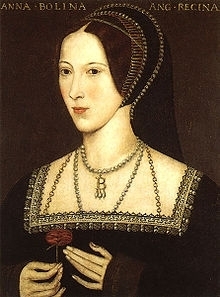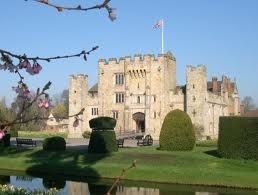Barbara Kyle's Blog: The Rest of the Story - Posts Tagged "anne-boleyn"
Anne Boleyn and the Colonel: A Tale of Hever Castle

I welcome every message from readers, but there's one I particularly cherish. It concerns an acorn, a castle, and a gallant Colonel.
Here’s the story.
Several years ago I was in England researching The Queen’s Lady, the first book in my Thornleigh Saga series, and I spent a day exploring Hever Castle in Kent. This was the home of the Boleyn family, and Henry VIII came here to court Anne. That tempestuous affair, as we know, changed the course of England’s history—and is pivotal to my book’s plot.
As I strolled the grounds in a happy haze of imagination, I picked up an acorn. I squirreled it away in my pocket and brought it home to Canada, and it sat on my desk beside my computer, a potent reminder of its birthplace as I wrote The Queen’s Lady.
The acorn was still on my desk when I wrote my next Thornleigh Saga book, The King's Daughter. It had become a touchstone that spirited me back to the Tudor world. I was very fond of it.
Then my husband and I moved, and in the shuffle the little acorn got lost.
A few months later I got a cheery email from a reader telling me he was on his way to England for an “Anne Boleyn Tour” during which he’d be staying at Hever Castle. There would be dinners in the great hall where Henry and Anne ate, plus lectures, plays, and demonstrations – “A once in a lifetime experience,” he said. I replied to wish him a happy trip and told him about my acorn. He's a retired US Air Force colonel. His name is Elmer K. Follis and he lives in Tennessee.

Some time later a small package arrived in my mailbox. It was from Colonel Follis. Inside was a note: “I looked for an acorn to replace the one you lost but couldn’t find one. I did get you this.” Nestled under the note was a pine cone. He had scoured the Hever grounds for it. “It’s from the area where Henry courted Anne, according to the castle staff,” wrote the Colonel.
I was so touched. Since then, the pine cone has had pride of place on my desk beside my computer as I've written four more Thornleigh Saga books.
Thank you, Colonel Follis, for what you gave me: a once in a lifetime experience.

*
Visit my website: http://www.barbarakyle.com/
*****
Published on February 20, 2014 07:33
•
Tags:
anne-boleyn, henry-viii, thornleigh-saga
For Sale: Rich Orphans - The Tudor Court of Wards
 In the late 15th century a young woman named Jonet Mychell was abducted.
In the late 15th century a young woman named Jonet Mychell was abducted. Her stepfather, Richard Rous, wrote to the Chancellor of England asking for help. According to Rous, Jonet had been living with her uncle in London when some "evil disposed" people led by one Otis Trenwyth took her away so that "neither father nor mother, nor kin nor friend that she had could come to her, nor know where she was."
Jonet was subsequently forced to marry against her will to "such a person that was to her great shame and heaviness." (The painting to the left by Eleanor Fortescue Brickdale is of an unnamed Tudor woman.)
To our eyes a man abducting a young woman is usually a sexual crime. But Tudor eyes saw things differently. The dispute in Jonet Mychell's abduction was about wardship and marriage, and what those two things entailed, above all, was money. What concerned Tudor bureaucrats was the abduction of young women who were heirs to property.
Abduction of heiresses was not uncommon. It occurred frequently enough to necessitate a statute passed in 1487 under Henry VII, the first Tudor monarch: "An Act Against Taking Away of Women Against Their Will." Because a stolen heiress meant lost revenues for the Crown.
The royal revenue stream went back for centuries. The wardship of minor heirs of any tenant-in-chief was one of the king's ancient feudal rights, a royal prerogative dating back to the feudal principle of seigneurial guardianship. It entitled the king to all the revenues of the deceased's estate (excluding lands allocated to his widow as dower) until the heir reached the age of majority: twenty-one for a male, fourteen for a female. The king generally sold the wardships to the highest bidder or granted them gratis to favored courtiers as a reward for services.
In other words, all orphans, male and female, who were heirs to significant property became wards of the king, who then sold the wardships. Gentlemen bid for these sought-after prizes, because control of a ward's income-generating lands and their marriage was a significant source of revenue. The guardian pocketed the rents and revenues of the ward's property until the young person came of age, at which time the guardian often married the ward to one of his own children.

When Henry VIII, the second Tudor monarch (that's him above) came to the throne he fully exploited the royal right of wardships. Monarchy had to be a money-making business, and wardships provided an excellent way to replenish the royal treasury. Surveyors were appointed to search for potential royal wardships throughout the realm. Managing all of this was a Master of the King's Wards who supervised royal wardships and administered the lands and revenues of wards during the period of crown control, and sold those not to be retained. The revenues supplemented the king's private funds.
In 1540 Henry VIII replaced the office of Master of the King's Wards with the Court of Wards, which assumed complete control of wards and the administration of their lands and the selling of the wardships. By the reign of Elizabeth I, the last Tudor monarch, the Court of Wards had become one of the crown's most lucrative ministries.
I became familiar with the situation of royal wardships when I wrote The Queen's Lady. My novel features Sir Thomas More, Henry VIII's chancellor, who famously went to the execution block rather than swear the oath that Henry was supreme head of the church in England, a title Henry created in order to divorce Catherine of Aragon and marry Anne Boleyn.

Sir Thomas More (above, wearing his chain of office) had two wards, Anne Cresacre and Giles Heron. He brought them up in his household where they were educated alongside his children. Eventually Anne married More's son John, and Giles married More's daughter Cecily. The marriages seem to have been happy ones.

The wonderful portrait of Anne Cresacre above is by Hans Holbein.
Anne Cresacre's story inspired me to create another ward for Sir Thomas More: Honor Larke, the heroine of my novel The Queen's Lady. Honor grows up revering More and becomes a lady-in-waiting to Queen Catherine of Aragon. Forced to take sides in the religious extremism of the day, Honor fights to save the church's victims from death at the stake, bringing her into conflict with her once-beloved guardian. She enlists Richard Thornleigh, a rogue sea captain, in her missions of mercy, and eventually risks her life to try to save Sir Thomas from the wrath of the King.

To read more about The Queen's Lady click on the Goodreads image below:

Visit my website: http://www.barbarakyle.com/
Published on April 10, 2014 18:28
•
Tags:
anne-boleyn, court-of-wards, henrcy-viii, sir-thomas-more, tudor, tudors



